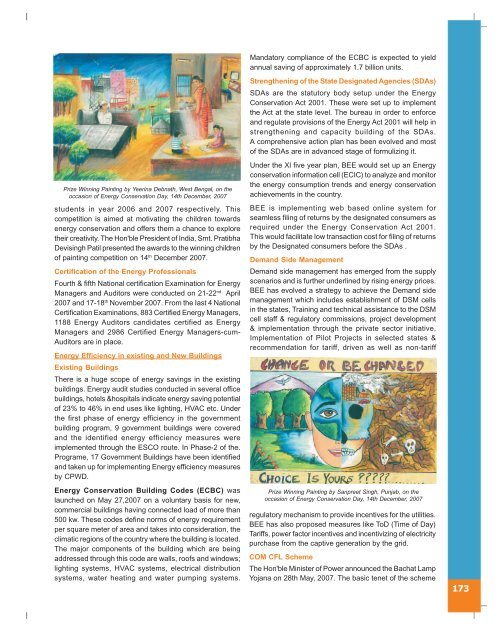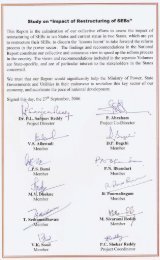MoP - Ministry of Power
MoP - Ministry of Power
MoP - Ministry of Power
Create successful ePaper yourself
Turn your PDF publications into a flip-book with our unique Google optimized e-Paper software.
Prize Winning Painting by Yeerina Debnath, West Bengal, on the<br />
occasion <strong>of</strong> Energy Conservation Day, 14th December, 2007<br />
students in year 2006 and 2007 respectively. This<br />
competition is aimed at motivating the children towards<br />
energy conservation and <strong>of</strong>fers them a chance to explore<br />
their creativity. The Hon'ble President <strong>of</strong> India, Smt. Pratibha<br />
Devisingh Patil presented the awards to the winning children<br />
<strong>of</strong> painting competition on 14 th December 2007.<br />
Certification <strong>of</strong> the Energy Pr<strong>of</strong>essionals<br />
Fourth & fifth National certification Examination for Energy<br />
Managers and Auditors were conducted on 21-22nd April<br />
2007 and 17-18th November 2007. From the Iast 4 National<br />
Certification Examinations, 883 Certified Energy Managers,<br />
1188 Energy Auditors candidates certified as Energy<br />
Managers and 2986 Certified Energy Managers-cum-<br />
Auditors are in place.<br />
Energy Efficiency in existing and New Buildings<br />
Existing Buildings<br />
There is a huge scope <strong>of</strong> energy savings in the existing<br />
buildings. Energy audit studies conducted in several <strong>of</strong>fice<br />
buildings, hotels &hospitals indicate energy saving potential<br />
<strong>of</strong> 23% to 46% in end uses like lighting, HVAC etc. Under<br />
the first phase <strong>of</strong> energy efficiency in the government<br />
building program, 9 government buildings were covered<br />
and the identified energy efficiency measures were<br />
implemented through the ESCO route. In Phase-2 <strong>of</strong> the.<br />
Programe, 17 Government Buildings have been identified<br />
and taken up for implementing Energy efficiency measures<br />
by CPWD.<br />
Energy Conservation Building Codes (ECBC) was<br />
launched on May 27,2007 on a voluntary basis for new,<br />
commercial buildings having connected load <strong>of</strong> more than<br />
500 kw. These codes define norms <strong>of</strong> energy requirement<br />
per square meter <strong>of</strong> area and takes into consideration, the<br />
climatic regions <strong>of</strong> the country where the building is located.<br />
The major components <strong>of</strong> the building which are being<br />
addressed through this code are walls, ro<strong>of</strong>s and windows;<br />
lighting systems, HVAC systems, electrical distribution<br />
systems, water heating and water pumping systems.<br />
Mandatory compliance <strong>of</strong> the ECBC is expected to yield<br />
annual saving <strong>of</strong> approximately 1.7 billion units.<br />
Strengthening <strong>of</strong> the State Designated Agencies (SDAs)<br />
SDAs are the statutory body setup under the Energy<br />
Conservation Act 2001. These were set up to implement<br />
the Act at the state level. The bureau in order to enforce<br />
and regulate provisions <strong>of</strong> the Energy Act 2001 will help in<br />
strengthening and capacity building <strong>of</strong> the SDAs.<br />
A comprehensive action plan has been evolved and most<br />
<strong>of</strong> the SDAs are in advanced stage <strong>of</strong> formulizing it.<br />
Under the Xl five year plan, BEE would set up an Energy<br />
conservation information cell (ECIC) to analyze and monitor<br />
the energy consumption trends and energy conservation<br />
achievements in the country.<br />
BEE is implementing web based online system for<br />
seamless filing <strong>of</strong> returns by the designated consumers as<br />
required under the Energy Conservation Act 2001.<br />
This would facilitate low transaction cost for filing <strong>of</strong> returns<br />
by the Designated consumers before the SDAs .<br />
Demand Side Management<br />
Demand side management has emerged from the supply<br />
scenarios and is further underlined by rising energy prices.<br />
BEE has evolved a strategy to achieve the Demand side<br />
management which includes establishment <strong>of</strong> DSM cells<br />
in the states, Training and technical assistance to the DSM<br />
cell staff & regulatory commissions, project development<br />
& implementation through the private sector initiative,<br />
Implementation <strong>of</strong> Pilot Projects in selected states &<br />
recommendation for tariff, driven as well as non-tariff<br />
Prize Winning Painting by Sanpreet Singh, Punjab, on the<br />
occasion <strong>of</strong> Energy Conservation Day, 14th December, 2007<br />
regulatory mechanism to provide incentives for the utilities.<br />
BEE has also proposed measures like ToD (Time <strong>of</strong> Day)<br />
Tariffs, power factor incentives and incentivizing <strong>of</strong> electricity<br />
purchase from the captive generation by the grid.<br />
COM CFL Scheme<br />
The Hon'ble Minister <strong>of</strong> <strong>Power</strong> announced the Bachat Lamp<br />
Yojana on 28th May, 2007. The basic tenet <strong>of</strong> the scheme<br />
173

















